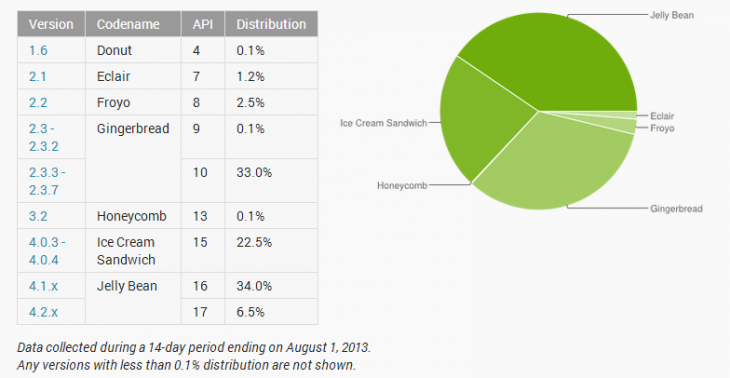
Last month was a significant one for the Android ecosystem since it marked the first time the Jelly Bean (Android 4.1/4.2) build overtook Gingerbread as the most used version of the operating system.
Google just released its figures for July, and there’s further growth for Jelly Bean, which has jumped from 37.9 percent of Android users to 40.5 percent. However, just 6.5 percent of devices run the Android 4.2 system, up from 5.6 percent in June — the one-week-old Android 4.3 naturally doesn’t register yet.
The figures, which are derived by looking at devices that visit the Google Play store at least once each month, show that Ice Cream Sandwich declined from 23.3 percent in June, to 22.5 percent during July.
Looking at the legacy builds, Honeycomb remains at 0.1 percent, while Gingerbread is down 1 percentage point to 33.1 percent. Froyo is down from 3.1 percent to 2.5 percent, Eclair’s share fell from 1.4 percent to 1.2 percent and Donut remains an estimated 0.1 percent.
The figures are encouraging for Google, since it represents a continued adoption of its more advanced platform builds, although Jelly Bean remains below the 50 percent mark and Android 4.2 is below 10 percent of all active devices.
Android is about to get more fragmented with the introduction of the Android 4.3 build, which was announced last week. Featuring multi-user accounts, support for Bluetooth Smart technology and more, device makers and carriers — such as Sony — are already working to bring the update to devices and customers.
For now, Android 4.3 is available for the Galaxy Nexus, Nexus 4, original Nexus 7, new Nexus 7 and Nexus 10. Support for the Google Edition HTC One and Samsung Galaxy S4 is “coming soon”, Google says.
Google changed the way it measures Android builds earlier this year. Previously, the company would count devices that accessed a Google service within a given survey period, but now it is focused on the Google Play store.
That’s more useful for developers since it shows their target audience. The figures also reflect better for Google, with more advanced builds enjoying a greater share of adoption under the new system.
Headline image via Garry Knight / Flickr
Get the TNW newsletter
Get the most important tech news in your inbox each week.





